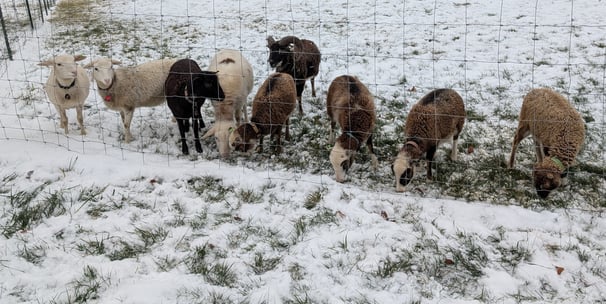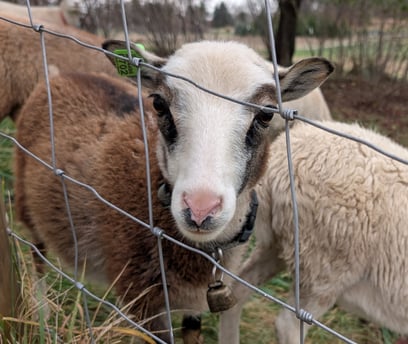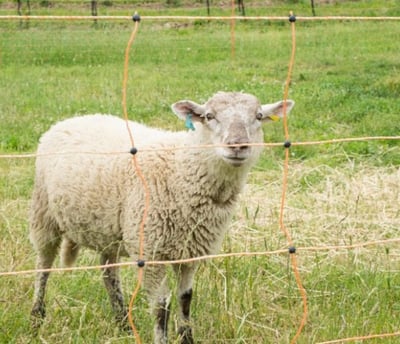Rotational Grazing
Rotational grazing is a pasture management system where a larger pasture area is divided into smaller sections, called paddocks, and livestock are moved through these paddocks on a schedule. This allows each paddock a dedicated "rest period" to regrow before being grazed again. It stands in contrast to continuous grazing, where animals have access to the entire pasture area all the time.
Implementing a rotational grazing system is one of the single most impactful things you can do to improve your pasture health, your sheep's well-being, and your farm's sustainability.


The Benefits of Rotational Grazing
Moving away from continuous grazing unlocks numerous advantages:
For the Pasture:
Increased Forage Production: By giving plants time to rest and regrow fully, rotational grazing often leads to significantly higher overall forage yields compared to continuously grazed pastures.
Improved Forage Quality: You can time your grazing periods so sheep are eating plants at their most nutritious and palatable stage, before they become overly mature and fibrous.
Enhanced Plant Persistence & Diversity: It prevents sheep from repeatedly grazing their favorite plants into the ground. This allows desirable grasses and legumes to recover, strengthen their root systems, and thrive, often leading to a more diverse and resilient pasture over time (Bear Creek Felting, 2023).
Better Manure Distribution: As sheep are concentrated on smaller areas for short periods, their manure (and valuable nutrients) is spread more evenly across the entire pasture, rather than being concentrated near shade or water sources.
Improved Soil Health: Regular rest periods allow for deeper root growth, which improves soil structure, increases organic matter, enhances water infiltration, and reduces erosion and runoff (The Grovestead, n.d.).
For the Sheep:
Better Nutrition: Sheep consistently get access to high-quality, fresh forage.
Significant Parasite Control: This is a major benefit! By moving sheep off a paddock before most parasite eggs they've shed can hatch and become infective larvae (which takes about 4-7 days in warm, moist weather), and not returning them until those larvae have died off (which requires long rest periods), you drastically reduce their exposure to internal parasites like the dangerous Barber Pole Worm (UGA Forage Extension Team, 2018).
Reduced Selective Grazing: In smaller paddocks, sheep are more likely to eat a wider variety of plants, leading to a more balanced diet and preventing certain plants from becoming dominant weeds.
Cleaner Environment: Spending less time in one area reduces mud buildup and keeps the grazing environment cleaner, improving hoof health and overall hygiene.
For the Farmer:
Extended Grazing Season: Well-managed rotational systems allow you to "stockpile" forage in some paddocks for later use, extending grazing into the late fall or even early winter, reducing hay needs.
Reduced Feed Costs: More and better pasture means less reliance on expensive hay and grain (Brimwood Farm, 2021).
Easier Flock Management: It's much easier to check on, handle, or catch sheep when they are in a smaller, defined paddock.
Better Land Utilization: You get more production out of every acre you own.
How to Implement Rotational Grazing
Setting up a system takes planning and some investment (primarily in fencing and possibly water systems), but it doesn't have to be overly complex, especially when starting out.
1. Paddock Design & Layout:
Number of Paddocks: More is generally better, as it allows for longer rest periods and more flexibility. Even starting with 4-6 paddocks is a huge improvement over continuous grazing. Highly intensive systems might have 20, 30, or even more (USDA, n.d.). The formula often used is: Number of Paddocks = (Days of Rest / Days of Grazing) + 1 (Mississippi State University Extension Service, n.d.).
Paddock Size: Size depends on your flock size and the amount of forage available. The goal is to have enough forage for your desired grazing period (e.g., 3 days) without forcing them to graze below 3-4 inches. You'll need to estimate forage availability and sheep intake (Sheep typically eat 2.5-3% of their body weight in dry matter daily).
Fencing: Electric fencing (high-tensile wire or poly-netting) is ideal for interior divisions due to its flexibility and lower cost compared to woven wire (Premier1Supplies, 2016). Ensure you have a strong charger and good grounding. Woven wire is best for the perimeter.
Water Access: This is a critical planning point. You need to provide fresh water in every paddock or design a laneway system that gives access to a central water source. Portable troughs can also work.
2. The Rotation Schedule:
Grazing Period: This is how long the sheep stay in one paddock. For intensive systems, this is typically short, ranging from 1 to 7 days. Shorter periods (1-3 days) generally lead to better pasture utilization and less selective grazing (Cornell Small Farms, 2018).
Rest Period: This is the time a paddock rests after being grazed. This is crucial for both plant regrowth and parasite control.
For Plant Health: Needs vary by season (shorter in spring, longer in summer/fall), often 20-60 days (Farm Stand App, 2025).
For Parasite Control: Longer is better. To significantly reduce larvae, rest periods of 45 to 70+ days are often recommended, especially during warmer months (UGA Forage Extension Team, 2018).
When to Move: Base your moves on forage height, not just the calendar:
Move Out: When sheep have grazed the pasture down to about 3-4 inches. Never graze shorter – this depletes plant root reserves and forces sheep to graze where parasite larvae are most concentrated.
Move In: When the pasture has regrown to about 8-12 inches (depending on species) and is in a leafy, vegetative state (before seed heads emerge).
3. Key Management Tips:
Be Flexible: Adjust your rotation speed based on how fast the grass is growing. You'll move faster in the spring and slower during dry spells or in the fall.
Observe: Watch your pastures and your sheep. Are the plants recovering well? Are the sheep getting enough? Is grazing even? Adjust as needed.
Start Simple: Don't feel you need 30 paddocks overnight. Start with a few, learn how your pasture responds, and gradually increase the intensity.
Soil Test: Ensure your soil pH and fertility are adequate to support productive pasture growth.


Rotational grazing is more management-intensive than set-stocking, but the benefits in terms of land health, animal health (especially parasite control), and farm productivity make it an incredibly worthwhile endeavor.


